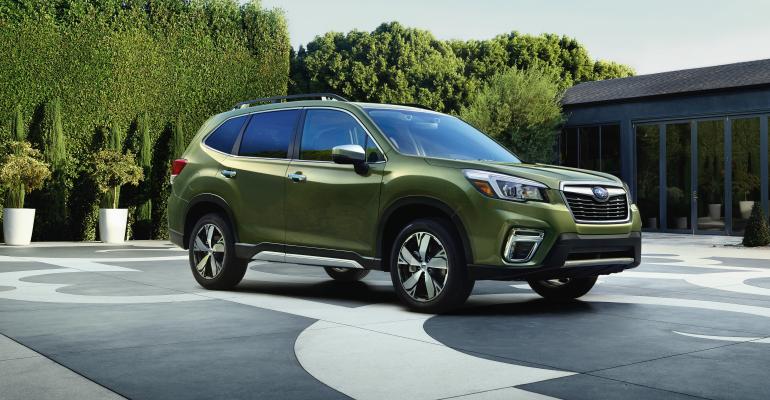ASHEVILLE, NC – The first automotive media ride-and-drive event I attended was in 1997 for the debut of the Subaru Forester compact CUV. It looked nice enough – but not stuck in a Washington state river alongside a road on our route.
Yet, that’s where a fellow journalist put it after losing control while driving. The Subaru PR guy at the time, Alex Fedorak, was not amused.
It would be much harder to unintentionally drive the redone 2019 Forester into a river. That’s because its safety technology all but prevents something errant like that happening (although human nature is such that someone, somewhere, somehow manages to do crazy stuff behind the wheel of a vehicle).
According to Wards Intelligence, Subaru is among the top six auto brands with the highest penetration rates of advanced driver-assist systems including blindspot alert, rear cross-traffic alert, lane-departure warning and collision mitigation.
The fifth-generation Forester has much else going for it, including an enhanced interior and larger dimensions. It’s the roomiest Forester to date.
Points of pride are two of the vehicle’s driver-assist technologies, Eyesight and the more-advanced DriverFocus, billed as a segment first and using facial-recognition to detect if a driver is sleepy or not paying sufficient attention to driving.
EyeSight Driver Assist includes two cameras on the rearview mirror. Scanning the road ahead, they work in conjunction with adaptive cruise control, pre-collision braking and lane-keeping assist.
A lot of other modern vehicles come with such safety features. But EyeSight is standard on all new Forester models. So is Subaru’s Symmetrical All-Wheel Drive.
DriverFocus is the more elaborate of the two systems and it’s on the top-of-line Forester Touring model. This advanced technology is the first of its kind in the compact CUV segment.
DriverFocus, working in concert with Eyesight, uses infrared sensors and facial recognition software to identify signs of driver fatigue or driver distraction. A mounted camera keeps an eye on the driver’s eyes. It detects if someone behind the wheel is not looking at the road or if their eyes are closed for more than three seconds.
If that happens, the driver gets an audible and visual warning designed to get the driver’s attention. It’s intended to get the point across but not scare the heck out of people, says Todd Hill, the Forester car line manager for Subaru of America.
 A less-dire extra feature of the DriverFocus facial recognition is that it also can identify and keep track of up to five different drivers, remembering preset preferences for each. That includes seat position, climate control and outside mirror placement. Plus, once recognized, you’re greeted with a personalized message.
A less-dire extra feature of the DriverFocus facial recognition is that it also can identify and keep track of up to five different drivers, remembering preset preferences for each. That includes seat position, climate control and outside mirror placement. Plus, once recognized, you’re greeted with a personalized message.
In the automotive history books, the Forester ranks as an original entrant in the now wildly popular compact CUV market.
The early Forester (in and out of the water) was downright dinky. The vehicle has grown up over the years, as evidenced by the new model, weighing in at 3,449 lbs. (1,502 kg). It’s bigger and roomier than before to meet modern customer expectations.
“We needed to grow it a bit to match the competition” says Hill. Competitors include the Toyota RAV-4 and Honda CR-V that also have bulked up in past years. “But we wanted to keep its compactness,” Hill says of the effort to not make the Forester look like a beefy compact CUV on steroids.
It’s the fourth Subaru on the Subaru Global Platform, designed to give vehicles better ride, handling, quietness, crash protection and agility. Mission accomplished there.
The Forester is mannerly on paved roads and confident on an off-road course, such as the one we went on in western North Carolina during a media event for the new vehicle. The vehicle went up and down rutted and muddy inclines without breaking a sweat. (And we kept it out of bodies of water.)
Powering the Forester is an updated 2.5L 4-cyl. Subaru Boxer engine, now with direct-fuel injection and a higher compression. It produces 182 hp (compared to 170 hp in the previous version) and 176 lb.-ft. (237 Nm) of torque (up 2 lb.-ft. from before).
The Forester has a continuously variable transmission, or a shiftless transmission, that’s redesigned to provide quicker acceleration and better fuel economy.
On the higher-trim Sport and Touring models, the CVT features a manual mode that simulates a 7-speed manual transmission. The driver uses steering-wheel paddle shift controls.
Prices range from $24,295 for the base model to $34,295 for the top-of-the-line Touring version. Subaru expects nearly 40% of Forester sales to be of the Premium model, one step up from the base model. Add a $975 destination fee to whichever of the five models is purchased.
Forester has accounted for 27% of Subaru deliveries in the U.S., just behind sales leader Outback, so it’s an important vehicle in the Japanese brand’s lineup.
Demographically, buyers tend to be in their late 30s and 52% of them are married. Sales skew slightly more toward women.
Of Forester buyers, 57% are new to the brand, 19% are on their third Subaru, 45% own a dog and 47% hike every now and then. Aftermarket options include a tent that sits atop the Forester’s roof and is accessible by ladder.
Dealer George Glassman of the Glassman Auto Group in Southfield, MI, says his Forester buyers often are active people looking for a vehicle with a dash of sportiness.
He recently sent a staffer to a regional event at which Subaru salespeople test-drove the new Forester as part of an initiative to familiarize themselves with the new product.
“Usually, salespeople balk at such events, preferring to stay at the dealership to sell cars, but this sales guy said the program was great because the vehicle is great,” Glassman says

.





